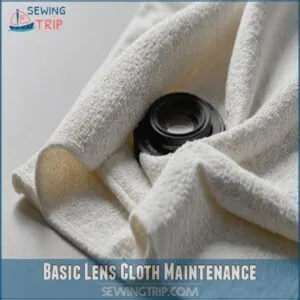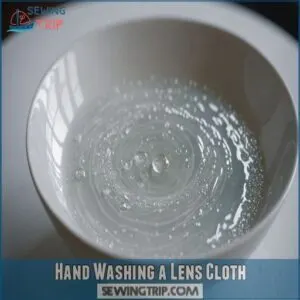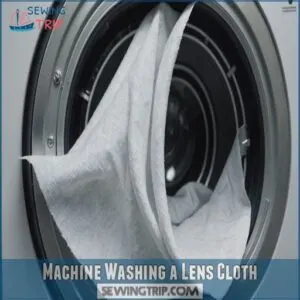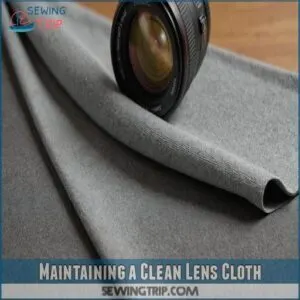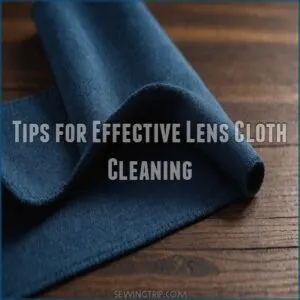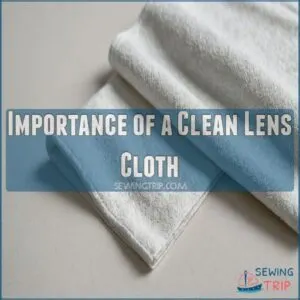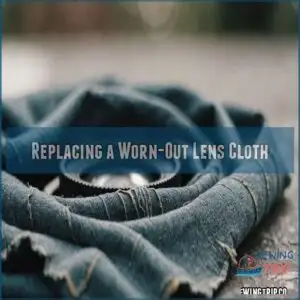This site is supported by our readers. We may earn a commission, at no cost to you, if you purchase through links.

Fill a small bowl with lukewarm water and add a drop of mild dish soap—skip the harsh detergents and fabric softeners that can leave residue. Gently agitate the cloth in the soapy solution for 2-3 minutes, then rinse thoroughly with cold water until no soap remains.
Air dry flat in a dust-free area, away from direct sunlight.
A clean lens cloth isn’t just about maintaining your gear; it’s about protecting your investment and ensuring streak-free results.
The real secret lies in knowing when your cloth needs more than just a basic wash.
Table Of Contents
- Key Takeaways
- Basic Lens Cloth Maintenance
- Hand Washing a Lens Cloth
- Machine Washing a Lens Cloth
- Common Mistakes to Avoid
- Maintaining a Clean Lens Cloth
- Tips for Effective Lens Cloth Cleaning
- Importance of a Clean Lens Cloth
- Signs of a Dirty Lens Cloth
- Replacing a Worn-Out Lens Cloth
- Frequently Asked Questions (FAQs)
- Conclusion
Key Takeaways
- You’ll get the best results by hand washing your lens cloth in lukewarm water with mild dish soap, then air drying it flat away from direct sunlight.
- Don’t use fabric softeners, bleach, or harsh detergents as they’ll leave residue and damage the microfibers that make your cloth effective.
- You can machine wash your cloth on a cold, delicate cycle without additives, but you’ll need to air dry it to preserve its cleaning ability.
- You should replace your lens cloth every 3-6 months with regular use, or sooner if you notice stains, discoloration, or reduced cleaning effectiveness.
Basic Lens Cloth Maintenance
You’ll keep your glasses crystal-clear by regularly maintaining your lens cleaning cloth, just like you’d take care of any essential tool in your toolkit.
A well-maintained cleaning cloth not only protects your expensive lenses from scratches but also makes sure you’re not just pushing around dirt and debris when you clean your glasses.
Shaking Off Dust and Debris
Before using your lens cloth, give it a good shake over a wastebasket to remove accumulated dust and debris.
This simple habit prevents tiny particles from scratching your lenses when cleaning.
Just like you’d want to clean your sewing machine regularly to keep it running smoothly, a clean lens cloth helps protect your camera or glasses from dust and grime.
Hold the cloth by its corners and gently snap it like you’re shaking out a small towel.
You’ll be surprised by how much dust falls off – it’s like giving your cloth a mini workout.
Using Compressed Air to Clean
After shaking off loose debris, compressed air becomes your secret weapon for deep-cleaning your lens cloth.
Here’s what you need to know:
- Hold the can upright and spray in short bursts from 6 inches away
- Work systematically from one corner to the other
- Avoid tilting the can, which can release liquid propellant
Keep the pressure gentle – you’re cleaning a cloth, not launching a rocket into space!
Drying With a Blow Dryer
Your trusty blow dryer can help speed up lens cloth drying, but you’ll need a gentle touch.
Set it to the lowest heat setting and keep it at least six inches away from the cloth to prevent heat damage.
Move the dryer in a sweeping motion to make sure even airflow is achieved.
A quick 30-second blast is usually enough to get your cloth ready for action.
Avoiding Fabric Softener and Harsh Detergents
While it’s tempting to toss your lens cloth in with regular laundry, fabric softeners and harsh detergents spell trouble.
For effective cleaning of your lens cloth, consider using specialized products found at a cloth cleaner store.
These products leave behind residues that can smear your lenses and damage special coatings.
Stick to mild, lotion-free dish soap or microfiber cleaners.
Think of your lens cloth like a delicate sensor – it needs gentle care to keep performing at its best.
Hand Washing a Lens Cloth
You’ll need a gentle cleaning approach to keep your lens cloth working like new, just as you’d care for your favorite pair of glasses.
Once you’ve gathered your mild soap and cool water, you can transform your grimy cloth into a streak-fighting superhero in just a few simple steps.
Preparing a Mild Soap Solution
Basic cleaning still leaves tiny particles behind, so let’s step up our game.
Start with a small container of cold water – warm water can break down the cloth’s fibers, much like how it can damage delicate satin fabric care.
Add 2-3 drops of mild soap (dish soap or gentle hand soap), found that the cloth was a delicate fibers, but acofound that the cloth were still that the number of the Cloth, but the number of the that, but the Number of cloth,
Soaking The Cloth
Soaking microfiber lens cloths properly helps you thoroughly clean them and extend their lifespan.
Place the cloth in lukewarm, soapy water and let it soak for 5-10 minutes to break down oils and debris.
Here’s what happens during the soaking process:
- Soap molecules penetrate deep into microfiber fibers
- Dirt and oils gradually separate from the cloth
- Gentle agitation helps release trapped particles
- Water temperature stays consistent for best results
- Microfiber structure maintains its cleaning ability
Rinsing Thoroughly
Once you’ve soaked your lens cloth, rinse it thoroughly under cold running water until every trace of soap disappears. Gentle water pressure helps prevent damage while ensuring a pristine clean.
| Step | Duration | Water Temperature |
|---|---|---|
| Initial Rinse | 30 seconds | Cold |
| Soap Removal | 1 minute | Cold |
| Final Rinse | 30 seconds | Cold |
Test for soap residue by gently squeezing the cloth – if you see bubbles, keep rinsing.
Drying and Storage
After a thorough rinse, gently squeeze out excess water without wringing the cloth.
Lay it flat on a clean, white paper towel away from direct sunlight.
You’ll want to let it air dry completely – usually about 4-6 hours.
Once dry, store your cloth in a sealed plastic bag or dedicated storage case to keep dust and lint at bay.
Machine Washing a Lens Cloth
You’ll save time cleaning your lens cloth by tossing it in the washing machine on a cold, delicate cycle.
Just remember to skip the bleach and fabric softener, which can damage the delicate microfibers that keep your lenses sparkling clean.
Choosing a Delicate Cycle
Gentle care makes all the difference when machine washing your lens cloth. Select the delicate or hand wash cycle on your washing machine, using cold water to preserve the microfiber’s cleaning properties. Keep the spin speed low to prevent damage to the delicate fibers.
- Set the water temperature to cold (30°C/86°F maximum)
- Choose a short wash time (15 minutes or less)
- Use the lowest available spin speed setting
Avoiding Bleach and Fabric Softener
When machine washing your lens cloth, skip the bleach and fabric softener – they’re like kryptonite for microfiber.
These harsh chemicals break down the delicate fibers that make your cloth effective at cleaning.
Just stick to a mild, fragrance-free detergent.
Think of fabric softener as that well-meaning friend who actually makes things worse – it leaves a residue that can transfer to your lenses.
Air Drying The Cloth
Properly air drying your lens cloth helps it clean better the next time you use it.
Here’s what you need to know about the drying process:
- Choose a well-ventilated spot away from direct sunlight
- Hang the cloth using plastic clothespins to avoid rust marks
- Allow 2-4 hours for complete drying in normal conditions
- Keep away from heating vents and radiators
- Ensure good airflow around all sides of the cloth
Laying Flat to Dry
After air drying, lay your lens cloth on a clean, flat surface to make sure even drying and prevent wrinkles.
Here’s a quick guide to perfect flat-drying results:
| Surface Type | Best For | Avoid |
|---|---|---|
| Glass table | Quick drying | Direct sunlight |
| Clean towel | Moisture absorption | Uneven surfaces |
| Drying rack | Air circulation | Heated areas |
You’ll know it’s ready when the cloth feels completely dry to the touch, with no damp spots.
Common Mistakes to Avoid
You’ll be surprised how many common cleaning mistakes can turn your trusty lens cloth into a scratch-making menace.
While cleaning your lens cloth might seem straightforward, knowing what not to do is just as important as knowing the proper cleaning steps.
Using Bleach or Harsh Chemicals
The harsh reality is that bleach and strong chemicals are lens cloth killers. They’ll break down those delicate microfibers faster than you can say "streak-free."
Instead of reaching for the heavy-duty cleaners, stick to mild soap and water. Your lens cloth isn’t bulletproof – those powerful chemicals can weaken the fibers, reduce cleaning effectiveness, and even leave residue that could scratch your lenses.
Exposing to Direct Sunlight or Heat
Direct sunlight and heat can turn your trusty lens cloth into a damaged cleaning companion.
UV rays and high temperatures break down the delicate microfibers, reducing their effectiveness and potentially introducing scratches to your lenses.
Here’s what excessive heat and sunlight can do to your lens cloth:
- Weakens fiber structure
- Causes fabric discoloration
- Reduces cleaning effectiveness
- Makes fibers brittle and prone to shedding
Putting in The Dryer
Tossing your lens cloth in the dryer might seem like a quick fix, but it’s a shortcut that’ll cost you.
Dryer heat can seriously damage these delicate cleaning tools, similar to how high heat can damage polar fleece and other sensitive materials, which is why you should check the washing instructions.
Here’s what happens when you use a dryer:
| Dryer Issue | Impact on Lens Cloth |
|---|---|
| High Heat | Melts microfibers |
| Tumbling | Creates static buildup |
| Lint Exposure | Collects debris |
| Temperature | Weakens fiber structure |
Always air dry your lens cloth to preserve its cleaning power.
Using Abrasive Cleaners
Harsh cleaning solutions might seem like a quick fix for a dirty lens cloth, but they’ll do more harm than good. Abrasive cleaners can break down microfiber fibers, reducing their effectiveness and potentially leading to lens damage. Stick to gentle, proven methods instead.
- Bleach leaving your cloth feeling stiff and brittle
- Ammonia-based cleaners dissolving delicate fibers
- Strong detergents creating a waxy residue
- Chemical cleaners leaving an unpleasant smell
- Rough scrubbing causing pilling and fiber breakdown
Maintaining a Clean Lens Cloth
You’ll need to give your lens cloth the same care you give your glasses to keep it working its best.
Just like your favorite t-shirt, your lens cloth needs regular cleaning and proper storage to stay in top shape for streak-free cleaning.
Storing in a Clean Area
Keep your lens cloth pristine by storing it in a dust-free haven.
A clean desk drawer or eyeglasses case makes an ideal home, protecting it from airborne particles and everyday contamination.
Think of your cloth’s storage spot like a mini-sanctuary – it’ll thank you by keeping your lenses spotless.
Pro tip: dedicate a specific pocket in your bag or case exclusively for your cleaning cloth.
Cleaning Periodically
Regular cleaning of your lens cloth maintains its effectiveness, just like your glasses need daily care, and washing delicate fabrics like silk and velvet also require gentle methods to prevent damage.
You can find more fabric care tips for sewing at Fabric Care for Delicates.
Here’s what works best for most people:
- Clean your cloth every two weeks if you use it daily
- Wash after exposure to makeup or sunscreen
- Deep clean monthly if you use it occasionally
- Set a reminder on your phone for consistency
Replacing When Worn or Discolored
Even the best lens cloth will eventually show signs of wear.
Watch for these telltale indicators that it’s time for a replacement:
| Sign | What to Look For | Action Needed |
|---|---|---|
| Color | Yellowing or stains | Replace immediately |
| Texture | Rough or pilling surface | Time for a new cloth |
| Performance | Leaves streaks or smudges | Don’t risk your lenses |
Remember, a worn cloth can actually scratch your lenses, so don’t wait until it’s completely deteriorated to replace it.
Having Multiple Cloths
Savvy lens enthusiasts often keep multiple cleaning cloths handy for different uses.
Dedicate one cloth for your glasses, another for camera lenses, and a third for electronic screens.
This approach prevents cross-contamination and extends each cloth’s lifespan.
You’ll also save time by having clean backups ready when one needs washing.
Plus, it’s cost-effective compared to replacing a single overused cloth.
Tips for Effective Lens Cloth Cleaning
You’ll find that keeping your lens cloth in top shape isn’t rocket science, but it does require some specific care to maintain its cleaning power.
When you follow these simple yet effective cleaning tips, you’ll extend your cloth’s life and guarantee your lenses stay crystal clear every time you use it.
Using a Blow Dryer on a Low Setting
Occasionally, you’ll need a quick way to dry your lens cloth when time’s tight.
A blow dryer can be your secret weapon – just keep it on the lowest heat setting and hold it several inches away from the cloth.
Wave it back and forth gently for 30-45 seconds, ensuring even coverage.
This method’s perfect for those rushed mornings when you can’t wait for air drying.
Avoiding Direct Sunlight or Heat
Just like your favorite t-shirt fades in the sun, your lens cloth can suffer from direct sunlight and heat exposure.
While a low-heat blow dryer works for drying, prolonged heat exposure can damage the delicate microfibers.
Here’s what excessive heat and sunlight can do to your lens cloth:
- Break down the microfiber structure
- Cause the fabric to become brittle
- Reduce its cleaning effectiveness
Keep your cloth in a cool, dark place for the best results.
Not Using Fabric Softener
Skip the fabric softener when washing your lens cloth – it leaves behind a residue that can smear your lenses instead of cleaning them.
This waxy buildup reduces the cloth’s ability to trap dust and oils effectively.
Stick to mild, unscented detergents specifically designed for microfiber care.
If you’ve accidentally used fabric softener, wash the cloth again with just water to help remove the coating.
Cleaning The Cloth Regularly
Regular cleaning keeps your lens cloth performing at its best.
Think of it like your favorite t-shirt – the more you use it, the more often it needs washing.
Here’s how to maintain your cloth’s cleaning power:
- Set a weekly reminder to inspect your cloth for dirt buildup
- Wash after 15-20 uses or when visibly soiled
- Store in a sealed container between cleanings
- Replace every 3-6 months depending on use frequency
Importance of a Clean Lens Cloth
You’ll notice a dramatic difference in your glasses’ clarity when you use a clean lens cloth instead of one that’s been collecting dirt and oils.
A dirty cleaning cloth can transfer bacteria and debris back onto your lenses, making them harder to clean and potentially causing eye strain.
Preventing Streaks and Smudges
A clean lens cloth is your first defense against those annoying streaks and smudges on your glasses.
Here’s a breakdown of common issues and their solutions:
| Problem | Cause | Solution |
|---|---|---|
| Streaking | Dirty cloth | Wash weekly |
| Smudges | Oil residue | Use lens solution |
| Cloudy spots | Hard water | Use distilled water |
| Lint trails | Static buildup | Dampen cloth slightly |
| Fingerprints | Direct contact | Handle by edges |
You’ll notice immediately when your cleaning cloth isn’t performing at its best.
Maintaining Optimal Lens Performance
By maintaining a pristine lens cloth, you’re investing in your glasses’ long-term clarity.
A clean cloth effectively removes fingerprints and debris without scratching your lenses, ensuring top performance.
Think of your lens cloth as your glasses’ best friend – when it’s clean, it’ll keep your view crystal clear.
Don’t let a dirty cloth compromise your vision quality.
Reducing Bacteria Accumulation
When you neglect cleaning your lens cloth, it becomes a cozy home for bacteria that multiply faster than you’d think.
Just like washing your hands, keeping your cloth clean prevents transferring germs to your glasses and face.
A weekly wash with mild soap eliminates up to 99% of bacteria, while storing your cloth in a clean case between uses maintains its hygiene.
Improving Vision Clarity
A dirty lens cloth can turn your crystal-clear vision into a blurry mess.
You’ll notice the difference immediately when using a clean cloth – colors appear more vibrant, text looks sharper, and those pesky digital eye strain symptoms start to fade.
Whether you’re looking through blue light filters or standard lens coatings, proper cloth maintenance means you’ll catch every detail with pristine clarity.
Signs of a Dirty Lens Cloth
You’ll notice your lens cloth isn’t doing its job when your glasses still look cloudy after cleaning or you spot visible lint on the fabric.
If you can see stains, discoloration, or notice an unpleasant smell coming from your cloth, it’s definitely time for a thorough cleaning.
Visible Stains or Discoloration
Inspect your lens cloth for telltale signs of wear and tear.
Just like your favorite t-shirt, these cleaning companions can show their age through visible marks.
Here are three key indicators that your cloth needs attention:
- Yellow or brown spots that won’t wash out
- Dark patches from oil and makeup residue
- Faded areas where the microfiber has broken down
Don’t let these stains compromise your vision clarity.
Unpleasant Odor
Lingering between the fibers of your lens cloth, unpleasant odors signal it’s time for a deep clean.
Here’s what different smells might indicate:
| Odor Type | Likely Cause | Solution |
|---|---|---|
| Musty | Damp storage | Air dry in sunlight |
| Chemical | Residual cleaners | Hand wash with mild soap |
| Metallic | Mineral buildup | Vinegar rinse solution |
| Sour | Bacteria growth | Hot water sanitize |
Don’t let your cleaning cloth become a breeding ground for bacteria.
Reduced Cleaning Effectiveness
Your once-trusty lens cloth may be quietly losing its cleaning power.
If you’re noticing smudges remain after wiping or your glasses take longer to clean, your cloth might be past its prime.
Bad cleaning habits can turn your helper into a hindrance.
- Oil and dirt particles become deeply embedded in the fibers
- Repeated use without washing leads to cloth saturation
- Improper washing methods can damage the microfiber structure
- Heat exposure can melt or deform the cleaning surface
Visible Lint or Debris
Accumulated lint and debris on your lens cloth can turn into tiny scratching agents when cleaning your glasses.
Check for visible fibers, hair, or dust particles by holding the cloth up to natural light.
For tougher lint problems, consider using a lint remover tool.
If you spot these unwanted guests, it’s time for a cleaning session.
Regular inspection helps prevent transferring debris onto your lenses, ensuring your cloth maintains its gentle cleaning power.
Replacing a Worn-Out Lens Cloth
You’ll know it’s time to replace your lens cloth when you notice tears, worn spots, or it’s not cleaning your lenses as effectively as it used to.
If you spot any discoloration or the cloth leaves lint behind on your glasses, it’s best to invest in a fresh microfiber cloth to maintain crystal-clear vision.
Checking for Tears or Holes
When was the last time you checked your lens cloth for damage?
Hold it up to a bright light and look for any tears, holes, or worn spots that could trap debris and scratch your lenses.
If you spot any damage, consider purchasing a new one from a lens cloth replacement store – even a tiny tear can cause big problems.
Run your fingers gently across the surface to feel for any rough patches.
Inspecting for Discoloration
Regular inspection of lens cloths reveals telltale signs of aging through discoloration.
Spotting these changes early helps maintain the best cleaning performance and protects your valuable lenses from damage.
- Check for yellowing or graying patches that indicate chemical buildup
- Look for dark spots that might suggest mold growth
- Watch for fading in the original color, which signals wear from UV exposure
Assessing Cleaning Effectiveness
Testing your lens cloth’s effectiveness doesn’t need to be complicated.
You’ll want to evaluate both cleaning power and residue removal.
Here’s a quick guide to assess your cloth’s performance:
| Test Method | What to Look For | Action Needed |
|---|---|---|
| Glass Test | Streaks | Deep clean cloth |
| Light Test | Smudges | Rinse thoroughly |
| Lint Check | Debris | Wash or shake |
| Water Test | Beading | Machine wash |
| Touch Test | Smoothness | Hand wash |
Considering a Replacement
A well-maintained lens cloth can last several months, but you’ll know it’s time for a replacement when you notice decreased cleaning effectiveness.
Check for fraying edges, stubborn stains, or if your lenses aren’t getting as clean as they used to.
Most microfiber cloths cost between $5-15, making it worth investing in a new one rather than struggling with a worn-out cloth.
Frequently Asked Questions (FAQs)
How do you clean a lens?
Want crystal-clear vision?
First, rinse your lenses under lukewarm water.
Then, apply a tiny drop of dish soap.
Gently clean both sides.
Rinse thoroughly.
And dry with a clean microfiber cloth.
How do you clean a microfiber lens?
Hand wash your microfiber lens cloth in cold water with mild soap, avoiding fabric softener and bleach.
Rinse thoroughly, then lay flat to dry.
Don’t machine dry, as it can damage the delicate fibers.
Can You machine wash a microfiber lens cleaning cloth?
While you might think it’s risky, you can actually machine wash your microfiber lens cloth.
Use cold water on a delicate cycle.
Skip the fabric softener and dryer.
Then let it air dry flat.
How do I wash my eyeglass cleaning cloth?
You can wash lens cloths regularly using mild soap and water to eliminate built up grime and maintain their effectiveness. You can machine wash your eyeglass cleaning cloth on a cold, delicate cycle without bleach or fabric softener.
For hand washing, use mild soap and cold water, then let it air dry flat.
Can I wash a lens cleaning cloth?
Like a knight polishing armor, your lens cloth needs regular cleaning too.
You can wash it by hand using mild soap and cold water.
Or, machine wash it on delicate cycle without fabric softener.
Can I use Dawn to clean my eyeglass cloth?
Dawn dish soap works well for cleaning eyeglass cloths.
Mix a few drops with cold water, gently hand wash the cloth, and rinse thoroughly.
Skip fabric softeners or harsh detergents that could damage the material.
How to clean dirty microfiber cloth?
Stubborn dirt doesn’t stand a chance with this simple method.
Handwash your microfiber cloth in cold water with mild soap, rinse thoroughly, and air dry flat.
Skip fabric softeners to maintain cleaning effectiveness.
How often should I wash my glasses with a cleaning cloth?
You should clean your glasses daily with a microfiber cloth to prevent smudges and maintain clear vision.
For deeper cleaning with soap and water, aim for once a week depending on how quickly they get dirty.
Can I use vinegar to clean my lens cloth?
Vinegar isn’t recommended for cleaning lens cloths as it can damage the microfibers and leave a residue.
Stick to mild soap and cold water to maintain your cloth’s effectiveness.
Never use harsh chemicals.
How often should I replace my microfiber cloth?
With proper care, microfiber cloths last 300-500 cleanings.
Replace yours every 3-6 months if used daily, or when it feels rough, shows visible wear, or leaves streaks.
Don’t wait until it’s completely worn out.
Is boiling water safe for cleaning lens cloths?
Boiling water can damage the delicate microfiber material in your lens cloth.
Instead, stick to cold or lukewarm water with mild soap.
Hot temperatures break down the fibers and reduce the cloth’s cleaning effectiveness.
Which lens cloth materials last the longest?
Like a sturdy oak in a forest, high-quality microfiber cloths made from polyester and nylon blends offer the longest lifespan. You’ll get the best durability from 80/20 polyester-to-nylon ratio materials.
Can I share my lens cloth with other people?
It’s best not to share your lens cloth with others since it can transfer bacteria and oils between users.
Use separate cloths to maintain hygiene and prevent eye infections or irritation.
Conclusion
Sarah’s expensive camera lenses were getting smudged because she wasn’t cleaning her lens cloth properly.
Now that you know how to clean a lens cloth effectively, you’ll maintain crystal-clear vision and protect your valuable equipment.
Remember, a clean cloth is essential for streak-free results.
Whether you choose hand washing or machine washing, regular maintenance will extend your cloth’s life and keep your lenses pristine.
Make cleaning your lens cloth part of your regular gear maintenance routine.

